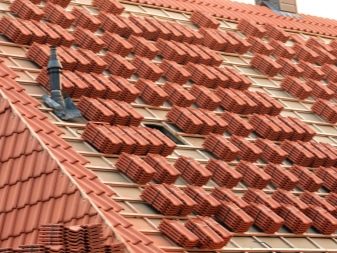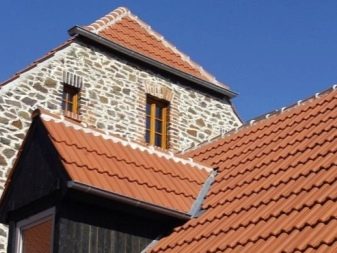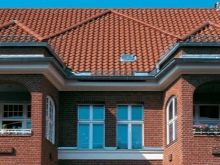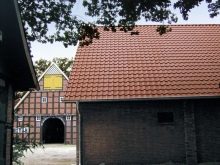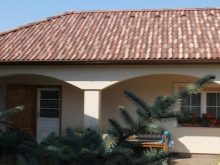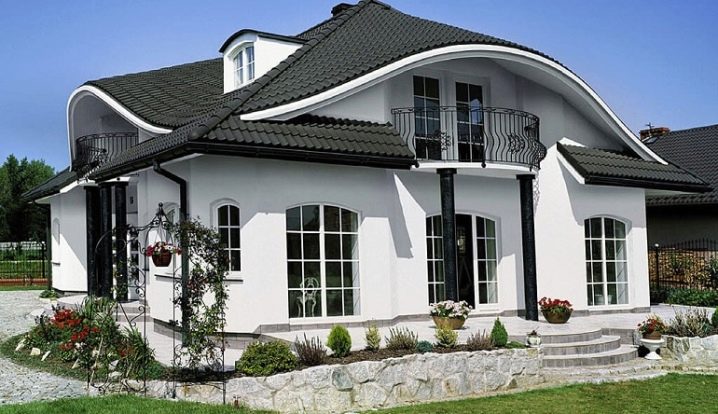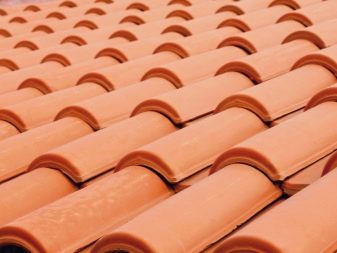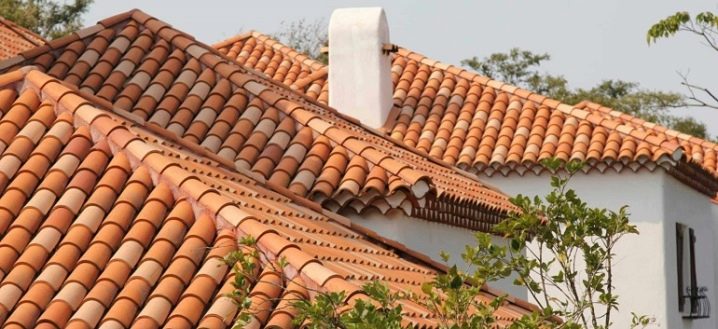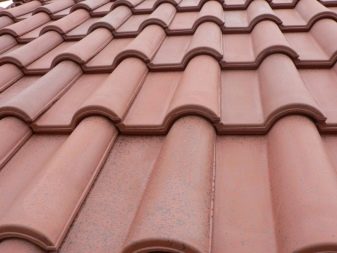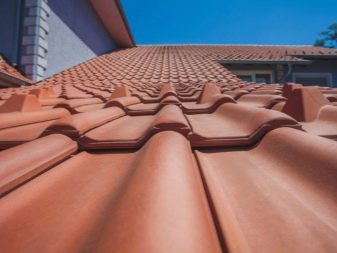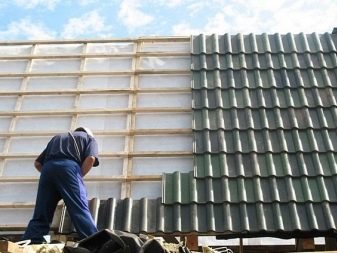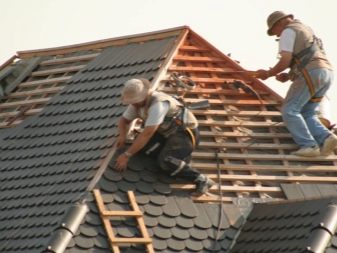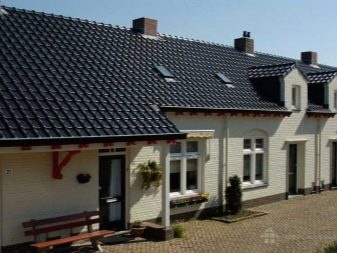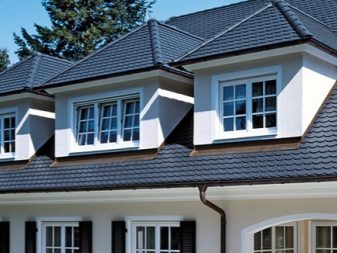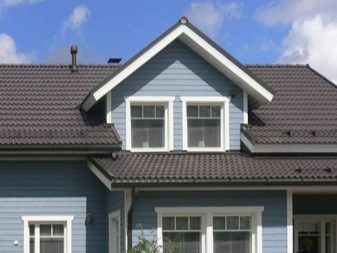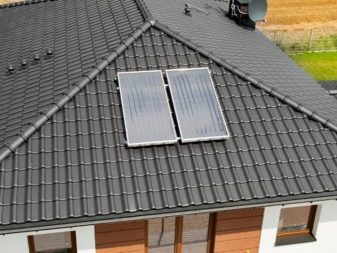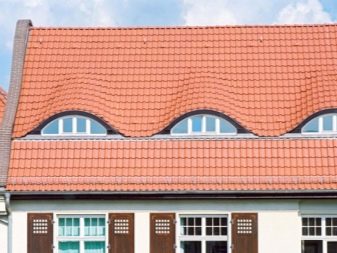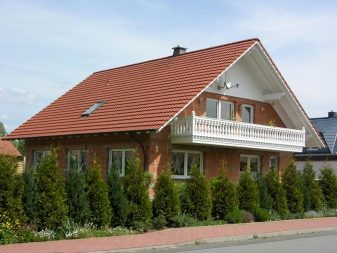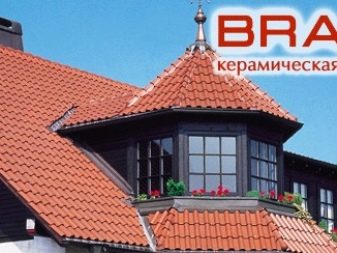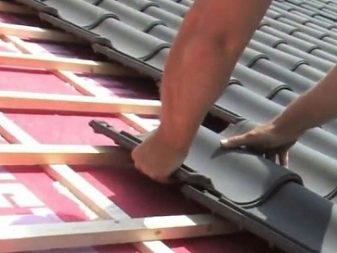Natural tile: features of the choice and subtlety of laying

Any construction of a house and household objects is accompanied by a roof covering. Therefore, the choice of material for the roof is considered a crucial step, since not only the appearance of the building, but also the life of the structure depends on it. The market is represented by a huge range of roofing products, each of which is different in design, quality and price. At the same time, special attention should be paid to natural tile, which can often be found in modern decoration of houses. It gives the building a chic look and is inexpensive.
Due to the special production technology, tiles are produced in different colors,fits perfectly into any exterior, and installation of the cover is simple, so that you can do it yourself.
Features and Purpose
Natural tile is one of the most popular materials used for roofing. It is made of clay and cement-sand mortar, therefore, ceramic and concrete tiles are distinguished. It also includes various additives and dyes. Thanks to modern firing technology, the product undergoes heat treatment at 1000 ° C, turns out to be very durable and acquires an original color. So that over time the material does not lose its aesthetic appearance, it is covered with a special protective film.
Unlike other types of coatings, shingles are considered environmentally friendly.therefore, it is widely used in the overlap of cottages and high-rise buildings. Roofs treated with this material can have both simple and complex forms, hip, gable and multi-pitched structures look especially beautiful. The product is well suited for houses and buildings, the angle of inclination of the roof in which ranges from 10 to 90 degrees, but the ceramic tile is best to choose for slopes of at least 22.The product can also be used for cladding vertical surfaces, it is interesting to look in the landscape design decorated with tiles not only residential buildings, but also baths, garages, gazebos.
This type of coating is perfectly combined with other materials, so it is chosen for buildings erected from wood, brick and stone.
Advantages and disadvantages
Natural tile is in great demand because it has many positive characteristics. Its main advantage is considered to be natural, the material is made from ecological raw materials, so it is absolutely safe for human health and does not emit harmful substances into the environment. The composition of the product includes several grades of clay and polymer additives that provide it plasticity.
Tile peculiar, and other advantages.
- Durability. For decades the product reliably serves and does not change its properties. Roof tiles do not require repair and remain airtight for over 100 years, protecting the structure from negative impacts.
- Aesthetics. The material is produced in different colors, so it harmoniously combines with any style of buildings, it looks especially good on the roofs of residential buildings.
- Fireproof.
- High resistance to temperature extremes.The coating can withstand both low and high amplitude (-150 С - +100 С).
- Good heat and noise and waterproofing. The product does not absorb moisture, prevents the penetration of environmental noise, slowly heats up and cools down.
- Strength. Roofing, tiled, does not require repair for 30 years. If, over time, minor defects appear on its surface, they are easy to eliminate. To do this, it is enough to dismantle the damaged area and lay a new material.
As for the shortcomings of coverage, the obvious ones should be highlighted.
- High price. Elite tile varieties are expensive, but affordable options are also available.
- Compliance with special installation technologies. Installation is simple, but in order to perform quality work, you need to know how to lay the material, because the end result and the lifetime of the roof will depend on it. In addition, the tile can not be used for every buildings. The building should be designed taking into account the mass of the coating, the weight of 1m2 of the coating can be from 20 to 60 kg. Therefore, bearing structures should be further strengthened.A huge role in the installation and plays the angle of the roof, installation is not allowed for structures with a slope of less than 10.
- Fragility. The product is made of clay; therefore, it is necessary to transport and stack it with the utmost care.
Varieties and Characteristics
To date, the construction market is represented by a huge selection of tiles, while the term “natural” tiles means a coating made from natural raw materials.
Depending on the components that make up the material, there are several groups of material.
- Thermoplast composite. The product is produced by mixing solid fillers, clay, thermoplastic polymers and dyes. Such material does not ignite, has a service life of up to 50 years and perfectly maintains the minimum temperature level.
- Lime-sand mixture. The coating is characterized by increased brittleness, since it is produced from silicate components that are roasted in an autoclave.
- Cement-sand mortar. The material reliably serves up to 70 years, it must be covered with acrylic paints, so it is resistant to moisture and ultraviolet radiation.Usually the tiles are covered with natural red or brown color, but there are also variations of other shades.
Natural tile undergoes special processing and, depending on what kind of coating was applied to the surface of its workpiece, it can be glazed or angoed. In the first case, the material is painted with a special solution, which, when fired, gives it a variety of shades, and in the second plate the products are protected with a glossy layer that prevents the penetration of moisture.
The tile also differs in shape and size. Small, medium-sized and large-format plates are on sale, their consumption per 1 m2, respectively, is 20, 15 and 10 pieces. As for the design features, the tile is divided into several types.
- "Beaver tail" (flat). It is characterized by a simplified version of the design and creates an airtight coating during installation. This tile is perfect for modular decoration of buildings in which the roof consists of curved parts and has a maximum angle. Since the installation is performed only overlap, the consumption of the product is large.
- Roman (antique). It is a complicated option, it is usually laid in two rows and used to shelter high roofs. It is recommended such tiles for buildings located in areas with low rainfall.
- Gutter. She peculiar presentable appearance. Due to the unique shape, it is possible to create both a monolithic and semicircular surface. The material is also used for the eaves. This type of tile is considered elite.
- Wavy. The material is S-shaped and, when laid, forms a wavy coating that is suitable for all types of roofs. The thickness of the tile plate does not exceed 50 mm, it is economically consumed, therefore it is most in demand.
In addition to the above types of products, there are also hip, ridge tiles and "Cascade". These models in the production provide special grooves that provide a secure fit.
How to calculate the amount of material?
Installation of tiles, like any other material begins with a preliminary calculation of all components. Therefore, first determine the surface area to be covered, and also make measurements of the slopes.Due to the fact that the tile is available in different sizes, it can be easily matched to the construction of a simple and complex shape. Since the product is characterized by a large weight, before installation it is also important to calculate the frame for strength and select the step of fastening the battens.
To do this, measure:
- roof length;
- the pitch of the boards on the overhang (can not exceed 390 mm);
- distance from the end of the board to the ridge (leaves 20-40 mm).
Material is calculated using a simple formula: N = (L - A - K): P, where N is the number of elements, L is the roof length, A is the distance from the batten to the ridge, P is the sheath step, K is the bottom overhang step. The result must be rounded up. In the event that the roof consists of several slopes, the material should be calculated for each of them separately.
Installation and installation: recommendations
Most homeowners prefer to put the roof on their own, as this is more economical. The installation process may seem complicated, but in fact it is not so to do the job properly, you should know the device of a tiled roof and lay the material, observing certain technologies.
This advice can help experienced masters.
- Start laying tiles need to prepare the roof. In contrast to the installation of sheet coverings, in this case it is necessary to fasten the boards along the entire perimeter of the building and put up fences along the overhangs. Measured the width and length of the skates, rafter legs, cornices and diagonal stingrays. After that, the angle of inclination of the roof is determined, if it makes the parameters from 22 to 65, then you can adjust the tile.
- Installation must be done overlap. For a roof with a slope of 25 it will be 100 mm, for 35-75 mm, for 45- 45 mm.
- The roof should be additionally protected from moisture, paving waterproofing. This is especially important for structures in which the angle of inclination is less than 22 or greater than 65. As a rule, rolled material is used as a waterproofing material, it is overlapped, leaving 150 mm to go down. To ensure the construction of good ventilation, waterproofing is best mounted with an indent from the ridge of 300 mm.
- The weight of the tile is large, so it is recommended to strengthen the building system before installation. Usually the rafters are made of 75 × 150 mm bars and set at a distance of 600 mm from each other. For crates, it is desirable to use a timber with a square cross section.
- To fix a tile it is necessary with the help of special clears and screws. Particular attention should be paid to mounting the cover in places that will be the most exposed to loads. If the slope of the roof exceeds 50, then the tile should be fixed on the plates of the previous row in a checkerboard pattern. The material will be securely fastened and will not slip.
- Only after all the preparatory work is completed, you can proceed to the immediate lining. To do this, carefully study the installation instructions, which are attached to the material from the manufacturer's plant. It is necessary to follow the whole procedure of installation.
- To raise the tile on the roof, it is first collected in piles of 6 pieces, then served up. On the roof surface, the material should be placed evenly, otherwise an excessive weight load will be created and the crate will not withstand it.
- Plates are placed from bottom to top and from left to right. The lower rows are fastened separately on screws and clamps. The main part of the material can simply be exposed to the crate without fixing, since the plates can hold on to their weight. If the house is located in areas where climatic conditions are characterized by wind and frequent rainfall,then the tile must be fixed. In this case, the first and last row set without fasteners.
- The installation of hip and hip roofs is performed from the center of the structure to the ridge. To do this, the first tile is exposed over the edge, it should be fixed given the descent.
- To ensure good ventilation from the bottom of the structure, special conclusions are made from under the skates. Thus, the lower part of the slope will be protected by an overhang, which will not allow moisture to enter under the casing. In the upper part of the roof, the rows under the edge are not needed to provide access to the air.
- The tile that covers the roof ridge must be attached to the timber. In order to maximally protect the structure from the wind, a 120 mm bevel is made on the gable roof. The plates on the sides are fixed with tiled sheets and fixed on nails. For hip roofing, the end of the structure is covered with a ridge, which is attached to the timber.
- To cover the roofs with a large area, it is recommended to choose special types of natural tile. Well in this case, suitable ventilation tiles. It is installed in one row between the rafters and, additionally, a “cross” or “tee” is attached to the roof.
Manufacturers
The natural tile is produced by both domestic and foreign manufacturers. Well-known brands offer high quality products, the price of which can be chosen considering the financial possibilities. So, the German mark has proven itself well. Creaton AGIt is known on the market for more than 125 years and produces more than 25 types of ceramic tiles. The material has received many positive reviews, although it is considered expensive. Coverage is also in high demand. Shinglas, Queentile. They produce products of various textures and colors, even selling hand-made tiles.
Popular in the decoration products Aura, Iko. Factories manufacturers presented it in an interesting geometry, which allows you to design houses in the Mediterranean style. Long-lasting and excellent quality is characterized by shingles from manufacturers A-Tiilikate, Koramic, von Muller and Jacobi, it is made according to a special technology, thanks to which the material is distinguished by an even coating and thickness. In addition, products are manufactured without microcracks and chips.
As for the Russian production, many reviews received products Braas. Russia works together with foreign partners and produces tiles in a wide model range.The product is resistant to temperature changes and external damage.
Tiles are made according to modern technologies, thanks to which it does not lose its original appearance for 50 years. In addition, the coating is convenient to install and is sold at an affordable price.
In this video you will find a master class on laying natural tiles.
